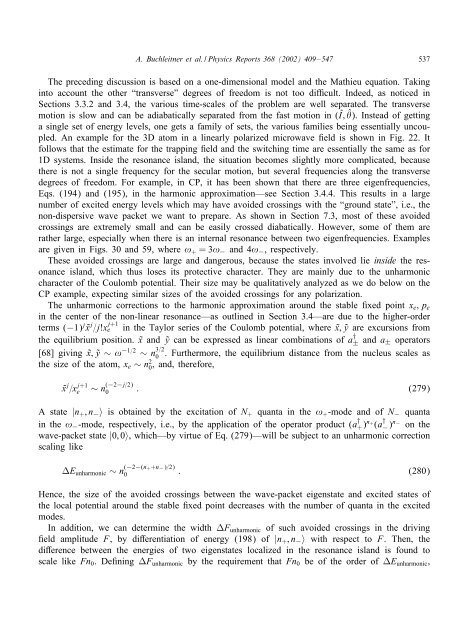Non-dispersive wave packets in periodically driven quantum systems
Non-dispersive wave packets in periodically driven quantum systems
Non-dispersive wave packets in periodically driven quantum systems
Create successful ePaper yourself
Turn your PDF publications into a flip-book with our unique Google optimized e-Paper software.
A. Buchleitner et al. / Physics Reports 368 (2002) 409–547 537<br />
The preced<strong>in</strong>g discussion is based on a one-dimensional model and the Mathieu equation. Tak<strong>in</strong>g<br />
<strong>in</strong>to account the other “transverse” degrees of freedom is not too di cult. Indeed, as noticed <strong>in</strong><br />
Sections 3.3.2 and 3.4, the various time-scales of the problem are well separated. The transverse<br />
motion is slow and can be adiabatically separated from the fast motion <strong>in</strong> (Î; ˆ ). Instead of gett<strong>in</strong>g<br />
a s<strong>in</strong>gle set of energy levels, one gets a family of sets, the various families be<strong>in</strong>g essentially uncoupled.<br />
An example for the 3D atom <strong>in</strong> a l<strong>in</strong>early polarized micro<strong>wave</strong> eld is shown <strong>in</strong> Fig. 22. It<br />
follows that the estimate for the trapp<strong>in</strong>g eld and the switch<strong>in</strong>g time are essentially the same as for<br />
1D <strong>systems</strong>. Inside the resonance island, the situation becomes slightly more complicated, because<br />
there is not a s<strong>in</strong>gle frequency for the secular motion, but several frequencies along the transverse<br />
degrees of freedom. For example, <strong>in</strong> CP, it has been shown that there are three eigenfrequencies,<br />
Eqs. (194) and (195), <strong>in</strong> the harmonic approximation—see Section 3.4.4. This results <strong>in</strong> a large<br />
number of excited energy levels which may have avoided cross<strong>in</strong>gs with the “ground state”, i.e., the<br />
non-<strong>dispersive</strong> <strong>wave</strong> packet we want to prepare. As shown <strong>in</strong> Section 7.3, most of these avoided<br />
cross<strong>in</strong>gs are extremely small and can be easily crossed diabatically. However, some of them are<br />
rather large, especially when there is an <strong>in</strong>ternal resonance between two eigenfrequencies. Examples<br />
are given <strong>in</strong> Figs. 30 and 59, where !+ =3!− and 4!−, respectively.<br />
These avoided cross<strong>in</strong>gs are large and dangerous, because the states <strong>in</strong>volved lie <strong>in</strong>side the resonance<br />
island, which thus loses its protective character. They are ma<strong>in</strong>ly due to the unharmonic<br />
character of the Coulomb potential. Their size may be qualitatively analyzed as we do below on the<br />
CP example, expect<strong>in</strong>g similar sizes of the avoided cross<strong>in</strong>gs for any polarization.<br />
The unharmonic corrections to the harmonic approximation around the stable xed po<strong>in</strong>t xe;pe<br />
<strong>in</strong> the center of the non-l<strong>in</strong>ear resonance—as outl<strong>in</strong>ed <strong>in</strong> Section 3.4—are due to the higher-order<br />
terms (−1) j ˜x j =j!x j+1<br />
e <strong>in</strong> the Taylor series of the Coulomb potential, where ˜x; ˜y are excursions from<br />
the equilibrium position. ˜x and ˜y can be expressed as l<strong>in</strong>ear comb<strong>in</strong>ations of a †<br />
± and a± operators<br />
[68] giv<strong>in</strong>g ˜x; ˜y ∼ ! −1=2 ∼ n 3=2<br />
0 . Furthermore, the equilibrium distance from the nucleus scales as<br />
the size of the atom, xe ∼ n2 0 , and, therefore,<br />
˜x j =x j+1<br />
e<br />
∼ n (−2−j=2)<br />
0 : (279)<br />
A state |n+;n−〉 is obta<strong>in</strong>ed by the excitation of N+ quanta <strong>in</strong> the !+-mode and of N− quanta<br />
<strong>in</strong> the !−-mode, respectively, i.e., by the application of the operator product (a † +) n+ (a †<br />
− )n− on the<br />
<strong>wave</strong>-packet state |0; 0〉, which—by virtue of Eq. (279)—will be subject to an unharmonic correction<br />
scal<strong>in</strong>g like<br />
Eunharmonic ∼ n (−2−(n++n−)=2)<br />
0 : (280)<br />
Hence, the size of the avoided cross<strong>in</strong>gs between the <strong>wave</strong>-packet eigenstate and excited states of<br />
the local potential around the stable xed po<strong>in</strong>t decreases with the number of quanta <strong>in</strong> the excited<br />
modes.<br />
In addition, we can determ<strong>in</strong>e the width Funharmonic of such avoided cross<strong>in</strong>gs <strong>in</strong> the driv<strong>in</strong>g<br />
eld amplitude F, by di erentiation of energy (198) of |n+;n−〉 with respect to F. Then, the<br />
di erence between the energies of two eigenstates localized <strong>in</strong> the resonance island is found to<br />
scale like Fn0. De n<strong>in</strong>g Funharmonic by the requirement that Fn0 be of the order of Eunharmonic,











